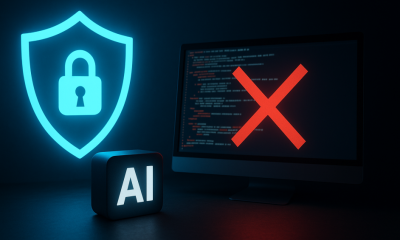Thought Leaders
AI is Already Inside Your Business. If You’re Not Securing It, You’re Behind

Whether or not you’ve officially rolled out AI across your organization, it’s already there. Employees are using ChatGPT to draft documents, likely uploading sensitive data into online tools to speed up analysis, and leaning on generative tools to shortcut everything from code to customer service. AI is happening with or without you, and that should keep CISOs up at night.
This quiet proliferation of unvetted AI tools across every department has created a new, fast-growing layer of shadow IT. It’s decentralized, largely invisible, and full of risks. From compliance violations to data leakage and untraceable decision-making, the consequences of ignoring this wave of AI use are real. Yet too many companies still think they can hold it at bay with policies or firewalls.
The truth is, AI can’t be blocked. It can only be secured. And the sooner companies accept that, the sooner they can start closing the dangerous gaps AI has already opened.
Shadow AI is infiltrating organizations, and it’s a security blind spot
We’ve seen this pattern before. Cloud adoption took off in the early 2010s exactly this way, with teams reaching for tools that helped them move faster, often without the security team’s approval. Many security teams tried to resist the change, only to be forced into reactive cleanup once breaches, misconfigurations, or compliance failures hit.
Today, the same thing is happening with AI. According to our 2024 State of AI Security Report, more than half of organizations are using AI to develop their own custom applications, and yet few have visibility into where those models live, how they’re configured, or whether they’re exposing sensitive data.
This creates two risks:
- Employees using public tools to access proprietary or sensitive data, which exposes that information to external systems without oversight.
- Internal teams deploying AI models without adequate security controls, which results in vulnerabilities that can be exploited and poor practices that could fail audits.
Shadow AI isn’t just a security issue, it can be a governance crisis. If you can’t see where AI is being used, you can't manage how it’s trained, what data it has access to, or what outputs it’s generating. And if you’re not tracking AI decisions, you lose the ability to explain or defend them, leaving you open to regulatory, reputational, or operational risk.
Why traditional security tools fall short
Most security tools weren’t built to handle AI. They don’t recognize model artifacts, can’t scan AI-specific data paths, and don't know how to track LLM interactions or enforce model governance. Even the tools that do exist tend to focus more on narrow pieces of the puzzle, leaving organizations juggling point solutions without a cohesive view.
That’s a problem. AI security can’t be an afterthought or a bolt-on. It has to be built into the way you manage your cloud environment, protect your data, and structure your DevSecOps pipelines. Otherwise, you’re underestimating how central AI is becoming to your operations and missing the opportunity to secure it as a core part of your business infrastructure.
The myth of “just block it” has to end
It’s tempting to think you can solve this with a blanket ban through policies of “no third-party AI tools” or “no internal experimentation.” But that’s wishful thinking. Simply put, employees today are using AI tools to get their work done faster. And they’re not doing it maliciously, they’re doing it because it works.
AI is a force multiplier and people will reach for it as long as it helps them meet deadlines, reduce toil, or solve problems faster.
Trying to block that behavior outright won’t stop it. It will just drive it further underground. And when something goes wrong, you’ll be in the worst possible position with no visibility, no policies, and no plan for response.
Embrace AI strategically, securely, and visibly
The smarter approach is to embrace AI proactively, but on your terms. That starts with three things:
-
Give employees safe, sanctioned options. If you want to steer usage away from risky tools, you need to offer secure alternatives. Whether it’s internal LLMs, vetted third-party tools, or integrated AI assistants in core systems, the key is to meet employees where they are, with tools that are just as fast but far more secure.
-
Set clear policies and enforce them. AI governance needs to be specific, actionable, and easy to follow. What kind of data can be shared with AI tools? What are the red lines? Who is responsible for reviewing and approving internal AI projects? Publish your policies and make sure your enforcement mechanisms, technical and procedural, are in place.
-
Invest in visibility and monitoring. You can’t secure what you can’t see. You need tools that can detect shadow AI usage, identify exposed access keys, flag misconfigured models, and highlight where sensitive data might be leaking into training sets or outputs. AI posture management is quickly becoming as critical as cloud security posture management.
CISOs need to lead this transition
Like it or not, this is a defining moment for security leadership. The role of the CISO is no longer just about protecting infrastructure. It’s becoming more about enabling innovation safely, which means helping the organization use AI to move faster while ensuring that security, privacy, and compliance are baked into every step.
That leadership looks like:
- Educating the board and executives on real vs. perceived AI risks
- Creating partnerships with engineering and product teams to embed security earlier in AI deployments
- Investing in modern tools that understand how AI systems work
- Building a culture where responsible AI use is everyone’s job
CISOs don’t need to be the AI experts in the room, but they do need to be the ones asking the right questions. What models are we using? What data is feeding them? What guardrails are in place? Can we prove it?
The bottom line: Doing nothing is the biggest risk of all
AI is already changing how our businesses operate. Whether it’s customer service teams drafting faster replies, finance teams analyzing forecasts, or developers accelerating their workflow, AI is embedded in day-to-day work. Ignoring that reality doesn’t slow the adoption, it just invites blind spots, data leaks, and regulatory failures.
The most dangerous path forward is inaction. CISOs and security leaders must accept what’s already true: AI is here. It’s in your systems, it’s in your workflows, and it’s not going away. The question is whether you’ll secure it before it creates damage that you can’t undo.
Embrace AI, but never without a security-first mindset. It’s the only way to stay ahead of what’s coming next.












